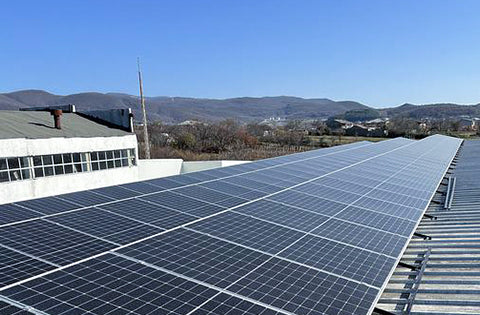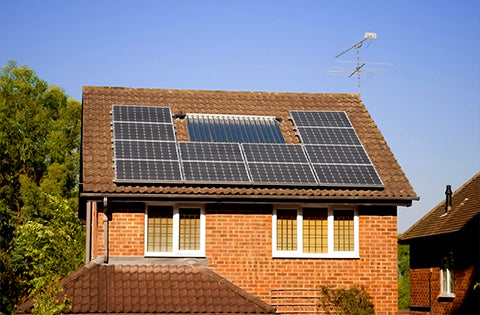Solar power
Solar energy is a renewable source of energy that is gaining ground because of the benefits it offers. In India, sunlight is available in abundance and there is technology available to harness this energy and convert it into electric power. Solar power panels serve the purpose of absorbing solar energy and converting it to electric power through the photovoltaic (PV) effect. Most homes have a roof or a backyard which can be utilized to install solar panels and produce electricity.
solarparts of a home solar system
A home solar system must provide enough electric energy to fulfil all the power requirements of a home. It should also be capable of providing AC power as traditionally all homes use AC power to operate lighting systems, gadgets, appliances and equipment such as computers, refrigerators, mixers, fans, air conditioners, TVs and music systems.
- It requires the adequate number of solar panels to absorb as much solar energy as possible. When exposed to direct sunlight a typical home solar panel produces about 300 watts in one hour which means that in a normal day during summer, comprising 10 hours of sunlight, it can produce around 3000 watts or 3 kWh per day. This could vary depending on the number of hours of sunshine received during the day.
- The system requires a battery which can be charged by the solar power generated and also can store electric power to be used in the night. Batteries are typically used in off-grid systems.
- The system needs an inverter to convert the DC power generated to AC power so that it can be used by the appliances or devices in the home.
-
The entire home solar power system is interconnected with adequate and appropriate cabling and wiring to channelize the energy into a usable form.
The working of a home solar system
When sunlight falls on the solar panels it gets absorbed by the PV cells and the silicon semiconductors in the cells convert the solar energy into electric energy through the PV effect. This electric energy is in the form of DC power which can directly charge the battery. The DC power in the battery is sent to an inverter which converts it into AC power. This AC power is now sent to the mains in the home which in turn can power all necessary applications.
Reach out to Top Solar Panel Dealers near you and get free quotes
Factors to consider
The factors to consider before setting up a home solar power plant are as follows:
The AC power required in the home is to be ascertained. The best way to ascertain this is to use the highest monthly electricity bill in the past year. The bill records the number of units of electricity consumed in that month. Dividing the units by the number of days in the month will give the daily consumption. Say if the highest consumption is 450 units in November 2018, then the daily consumption is 15 units and the requirement would be 15 units per day. One unit equals 1 kWh which is actually the usage of 1000 watts in 1 hour. For instance, if a 100 watt bulb glows for 10 hours it consumes 1000 watts or power equivalent to 1 kWh.
The number of solar panels needed to generate the required AC power is to be calculated. In the above example, the home requires 15 units per day which is equivalent to 15 kWh. This means that in 1 hour the solar panel must generate 15000 watts of power. Thus, if a panel can produce 3 kWh per day of 10 hours then 5 solar panels would be required to produce 15 kWh.
Based on the number of solar panels required, the availability of space to house the solar panels should be determined. This could be on the rooftop or backyard where the solar panels can receive adequate sunlight. In the above example, since the home solar power plant requires 5 solar panels, the area required is 17.6 x 5 = 88 square feet (assuming the solar panel is of size 65 x 39 inches = 17.6 square feet approximately). Most homes can provide this space on the rooftop or the backyard.
- The solar panels should ideally be placed facing south to maximize the fall of sunlight on them.
Cost of a home solar system
The cost of the home solar power plant depends on its size and type. There are two types of solar power plants – off-grid and grid-connected.
An off-grid system is a stand-alone system not connected to the main grid. In this system, solar energy generated is stored in batteries (known as deep cycle batteries different from the ones used in automobiles). The DC power stored in the batteries is converted into AC power by an inverter.
A grid-connected system is one which does not use batteries but only an inverter. Typically, a grid-connected system is governed by a statutory policy involving ‘net metering’ wherein the system records the excess electric power generated over and above the usage by the home that is fed to the grid. In this system, the home user need not worry too much about calculating the size of the power plant as any excess power generated earns revenue and any shortfall is made up by grid supply.
The benchmark cost of a typical 1 kW off-grid system generating 4-5 units of electric power can vary between Rs 1 lakh and 1.25 lakh. Similarly, the benchmark cost of a similar grid-connected system is generally between Rs 75,000 and Rs 90,000. The difference is mainly because of the cost of deep cycle batteries in the off-grid system.
An off-grid home solar system is an excellent cost-saving feature when planned properly and is capable of paying back the initial investment within the first 5 years of operation through savings in electricity bill. A grid-connected home solar system is both a cost-saving feature as well as a revenue earning system when planned with revenue earning as an objective.However, while off-grid home solar power plants are independent of the main grid, on-grid systems are subject to the regulations of the grid power supply provider. Thus, home users can choose an appropriate system depending on the circumstances prevailing in their localities.



